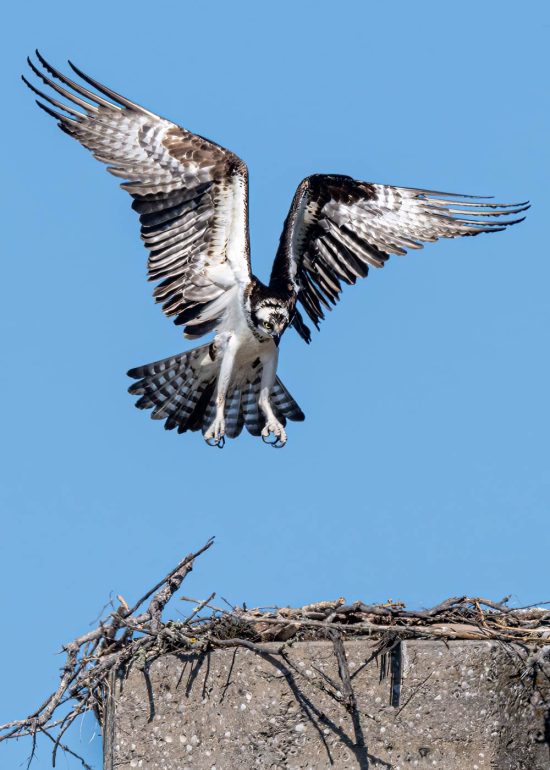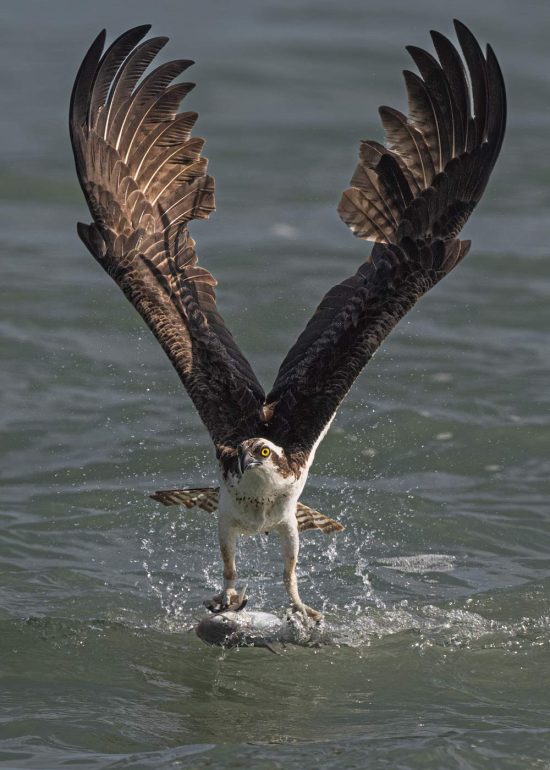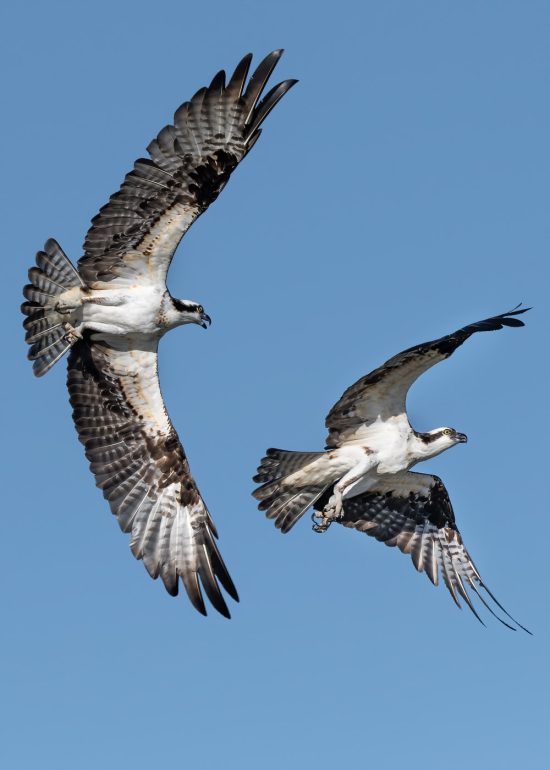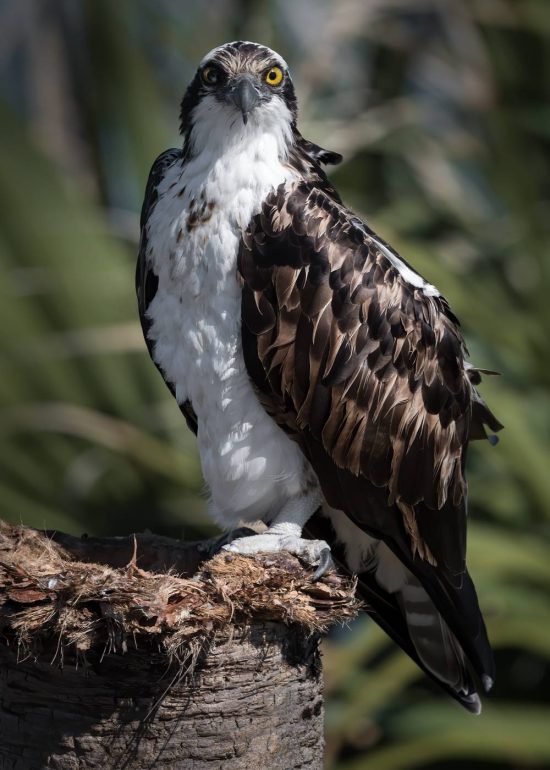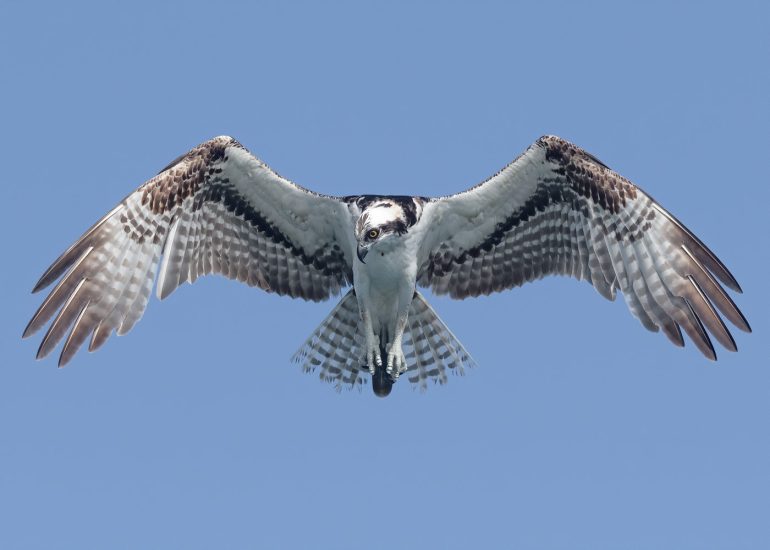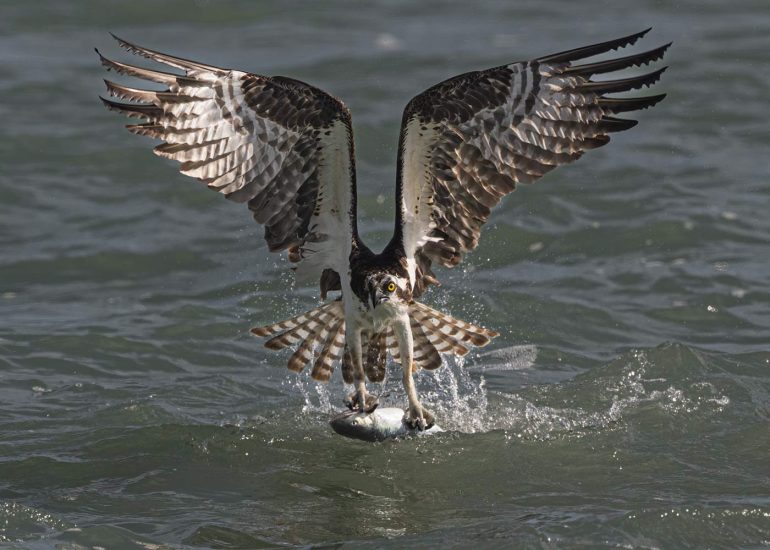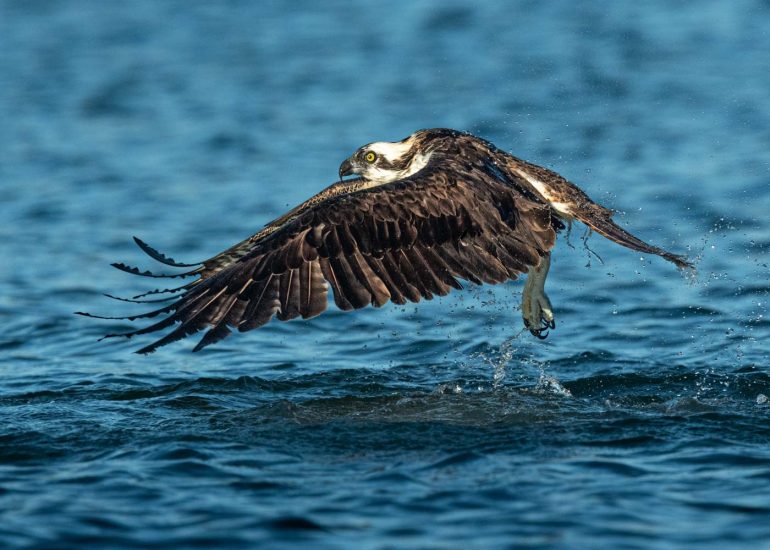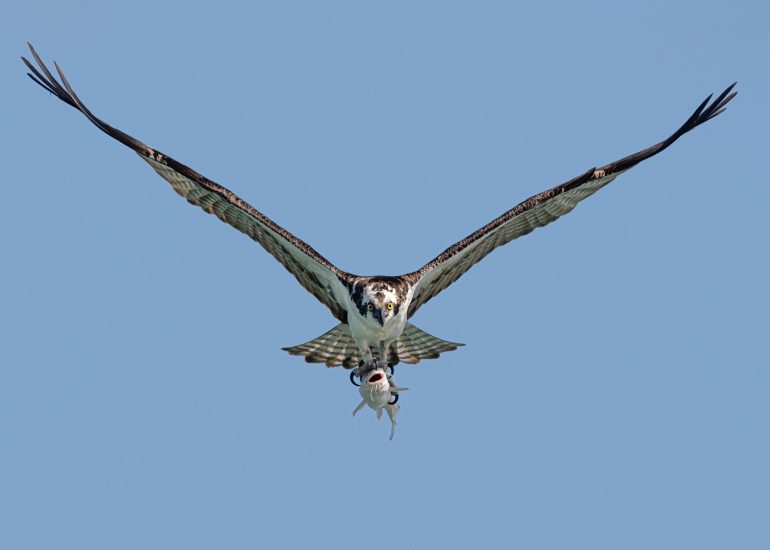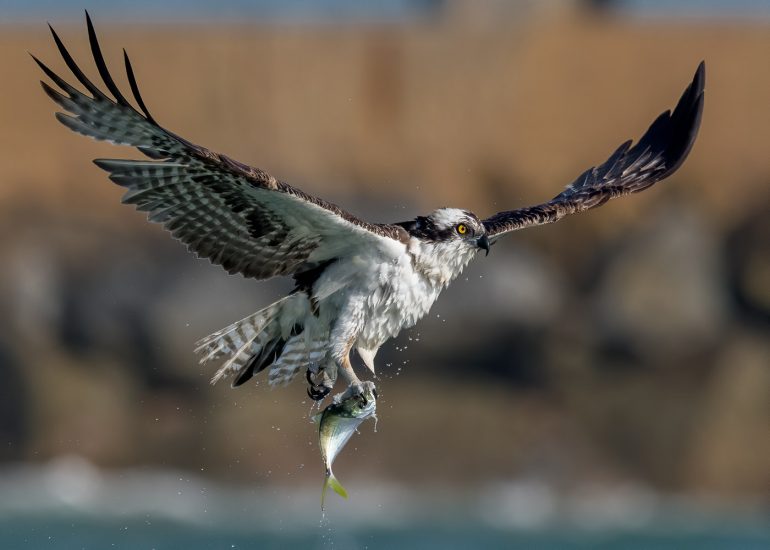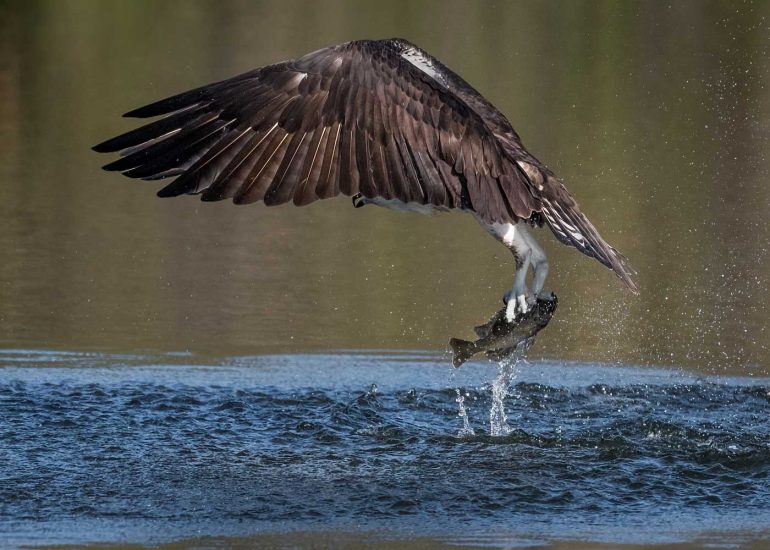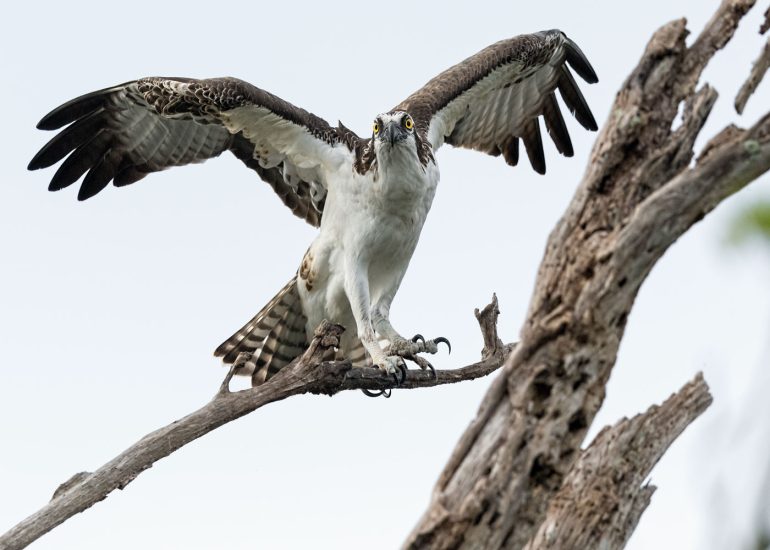Osprey

Majestic predators. That’s the perfect way to describe Ospreys. These carnivorous raptors are unique North American hawks, known mostly for their diet and foraging habits. Also called the “Fish Hawk”, the Osprey (Pandion haliaetus) is dignified and ferociously sly. Built similarly to a gull, these large birds dive for their food feet first and boast distinct plumage. They also happen to be easily identifiable from longer distances, which makes them a fan favorite among bird photography enthusiasts—myself included, naturally.
In my years photographing birds and other Florida wildlife, I’ve admired many Ospreys along the Sunshine State’s rapturous coastlines. They’re commonly seen flying near our shallow shores, patrolling inlets, and standing ever-so-gallantly on top of their large stick nests. Ospreys on the hunt are a sight to be seen, likened to what can only be described as the embodiment of perfect concentration. The next time you find yourself near shallow open water that’s swimming with lots of fish, listen for their distinctive high-pitched chirping or whistling calls overhead—it’s something to be heard, for sure!
Bird of Prey: About the Osprey
- Scientific Name: Pandion haliaetus
- Order: Accipitriformes (hawks, eagles, vultures, kites)
- Family: Pandiondae
- Conservation Status: Stable
- Size & Wingspan: About 2 feet tall; 5–6-foot wingspan
- Lifespan: 15-30 years
Identification
 Like Great Egrets, Ospreys are one of the most widespread birds in the world, found everywhere on the planet except Antarctica. These year-round residents of Florida weigh about three to four and a half pounds and are easily identified by their dark brown backs and narrowly crooked wings with contrasting white speckled plumage underneath, white heads, striking yellow eyes, and an impressively broad wingspan. The beak of an Osprey is black with a notable strong hook shape.
Like Great Egrets, Ospreys are one of the most widespread birds in the world, found everywhere on the planet except Antarctica. These year-round residents of Florida weigh about three to four and a half pounds and are easily identified by their dark brown backs and narrowly crooked wings with contrasting white speckled plumage underneath, white heads, striking yellow eyes, and an impressively broad wingspan. The beak of an Osprey is black with a notable strong hook shape.
Ospreys have abnormally long legs that are attached to their equally large feet—the largest of any hawk their size, in fact! These predatory avians possess rough gripping pads with imposing and curved razor-sharp talons that help them snatch fish quickly from the water and carry them considerable distances. All four talons are specialized and reversible, giving them unique capabilities that other raptors don’t share. Their toes are covered in spiny bumps known as ‘spinules’ that help them easily capture and hold onto any slippery prey. Watching them on the hunt is oddly invigorating, to say the least.
Measuring at about two feet tall and with a five to six-foot wingspan, Ospreys are slightly smaller than their Eagle counterpart; and interestingly, females are usually larger than males. At about 18 months old, Ospreys gain their full adult plumage.




Habitat
Unlike the flamboyant Reddish Egret that artfully scours for its prey, the Osprey dives for its food. However, they lack the ability to plunge lower than three feet underneath the surface and so they tend to be drawn toward shallow waters and fishing areas, visiting deeper bodies of water only where fish swim close to the top.
In North America, Ospreys nest and live in a number of places from Maine to Mexico with their habitats including pretty much any area that houses shallow, fish-abundant waters. This includes lakes, rivers, marshes, swamps, ponds, reservoirs, shallow coasts, and lagoons. Wherever they live, the Osprey needs an open area and sufficient supply of available food within approximately 12 miles of their elevated nests. Because of Florida’s humid subtropical climate, you’ll find these raptors all year long.
Behavior and Feeding
Fun fact: the Osprey is a piscivore and the only hawk in North America that almost only eats live fish! So much so that fresh and saltwater fish make up for about 99% of their diet. As I’m sure you can imagine, that makes them brilliant fishers and exciting for bird watchers to witness. Apart from fish, Ospreys will sometimes—albeit rarely—eat squirrels, muskrats, reptiles, snakes, or birds if their fish supply is sparse.
Really—and I mean really—good at flying and diving, Ospreys aren’t as flexible as other hawks which keeps them confined to fairly open areas. Their wingbeats are stiff and mimic a rowing motion when hovering waterways for food. Primarily singular birds, they usually perch alone or in small winter colonies of six to ten. Ospreys protect only the areas closest to their nest and in defense mode, they boldly chase other Ospreys that infringe upon their nesting territory.

Bird of Prey
When foraging, these primal aviators glide slowly over shallow or fish-heavy waters, pausing for just a moment to hover when it sees fish below. Once it has an eye on the prize, Ospreys plummet nose first—but only for a second—before it takes the slightest turn upward, landing feet-first to easily grab its unsuspecting next meal using its dramatically curved talons.

Once they’ve latched on, it’s like a steel trap; the feet of this master fisherman are no joke, and they don’t easily concede. Sometimes, a fish will be too big for this ambitious feathered warrior, and he’ll release them—but not before he leaves his mark forever on their backs. If you’ve ever seen a scar on the backs of various large trout, they’ve likely won a battle with an Osprey. On rare occasions, a larger fish can even pull an Osprey under the water and drown them.
 The fish most often caught by this unique raptor typically measure anywhere from six to 13 inches, weighing about half a pound. With that being said, there have been reports of Ospreys catching and eating fish weighing as much as two and a half pounds—that’s over half of their own bodyweight!
The fish most often caught by this unique raptor typically measure anywhere from six to 13 inches, weighing about half a pound. With that being said, there have been reports of Ospreys catching and eating fish weighing as much as two and a half pounds—that’s over half of their own bodyweight!
Oh, and fish aren’t just food for the Osprey—they’re the water supply too. When it comes to staying hydrated, it’s believed that they get the majority of the water they need from the flesh of their scaly prey; but even a fish hawk can find the Florida heat overwhelming. It’s not uncommon to see adults drinking from waterways on a sweltering summer day.

Nesting and Displays
If you live near water with a large living fish population, chances are that you’ve seen an Osprey nest. Crafty hawks indeed, they often build their stick-entwined home on top of power line poles, dead trees, snags, chimneys, cliffs, buoys, or other elevated man-made structures. They need their nests to be in open areas that allow for effortless landing, outfitted with a broad, solid base and protection from raccoons and other ground predators that enjoy dining on the raptor’s eggs.
Typically found by the male before the female arrives, Osprey nests are skillfully made with sticks and lined with grass, bark, vines, debris, sod, and even algae. The male does most of the work with gathering the materials—often by clipping dead branches of nearby trees as he soars through—while the female puts things where they need to be. Nests built on manufactured platforms, most notably during a pair’s first brood, are fairly small. In the beginning, Osprey nests average less than 2.5 feet around and three to six feet wide. After years of adding to their humble abode, nests can be three to six feet around and measure 10 to 13 feet wide—that’s easily large enough for the average person to sit in!
Breeding Osprey Displays
Ospreys are fiercely loyal to their nests and their partners; like Great Blue Herons, they are serial monogamists that in most cases mate for life. Unlike most other birds however, Ospreys reuse their nests over-and-over, hence why they grow so much in size over generations.
During breeding season, males perform rituals that consist of aerial sky dances known as “fish flights.” With his legs dangling beneath him and often with nesting materials or fish in an iron-clad grasp, he rotates his movements of hovering with slow, hollow swoops as high as 600 feet above the chosen nest site. After putting on this display for 10 minutes or more, he’s vocal with repeated scream-like calls and steadily makes his way downward toward to the nest, all the while hopeful that a potential mate might’ve noticed and is ready to start building their forever home.
In the event that Ospreys are unsuccessful in their breeding attempt, they typically start building a new nest called a ‘frustration eyrie’, which they’ll often use the following year.
Mating Season
Mating season for Ospreys takes place in the Spring, with one brood per season of one to four eggs that are slightly larger than jumbo chicken eggs—measuring at about 2.2 to 2.7 inches long and 1.6 to 2.0 inches in width. Osprey eggs are a light cream-colored pink to almost cinnamon with reddish-brown speckled spots. The incubation period lasts from 36 to 42 days and as devoted parents do, both the male and female partake in keeping them warm. Sixty days after breaking out of their shells, hatchlings are ready for their first flight.
Life Cycle
The average lifespan of an Osprey is typically 15 to 30 years, with reports of even living to be 35. It’s not so easy being a hatchling though and sadly, almost half of Osprey chicks die within their first year due to hunting deficiencies or predators like racoons and other raptors. But whatever unfolds in the life of these ravenous avians, over a period of six to eight weeks, mom will feed them shocking amounts of fish, they’ll mature to adult size, and gradually shed their fuzzy plumage as they sprout feathers that empower them to fly!
Florida Osprey & Bird Photography
As I’ve mentioned before in previous blog articles, I love taking pictures of birds and other wildlife South Florida has to offer. I love even more being able to share those images I’ve captured with the rest of the world so they can bask in the same sense of appreciation and awe that I get every time I’m looking through my lens.
Come fly with me and get an exclusive look at more of my work on the Osprey and other Florida birds by visiting the Dan Power Gallery. Everything you see here is also available for purchase at the Dan Power Gallery online store, available in a multitude of sizes, frame options, and surfaces.


